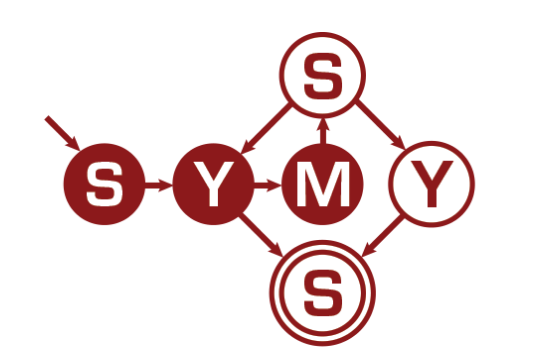
Machina
How to Submit to Machina, The Symbolic Systems Journal
The SymSys Society is currently accepting submissions for our 2025-26 annual journal Machina. The deadline is January 31, 2026 at 11:59pm.
Purpose
This isn’t exactly your classic academic journal. We’re looking for high quality submissions that excite people about SymSys and SymSys-related topics—your well-written PHIL 182 class paper, an excerpt from your short story about the metaverse, your art, etc! Machina is meant to be an accessible place for the average Stanford student where cool ideas come together in print.
Submission Guidelines
Written submissions should preferably be under 2000 words. Shorter or longer submissions are fine; editors will work with you to bring your paper to an acceptable length.
If you use any external sources, you must include a Works Cited in APA format.
Submissions should tackle topics related to Symbolic Systems, namely the interplay of fields such as computer science, psychology, philosophy, statistics, mathematics, and linguistics. Successful works will identify and analyze issues at the intersection of these fields. Possible topics may include (this is only a small sample of what you can write on!):
What is consciousness? Can machines be conscious?
Is math discovered or is it invented? Is there only one objective truth or multiple?
Is Artificial Intelligence inherently biased? How can we regulate it?
What is cognition? What is the relationship between emotion and cognition?
If necessary, edit the submission itself for accessibility. Think Scientific American rather than Nature.
Eligibility
Submissions are open to all current Stanford students, undergrad or grad.
You do not have to be a SymSys major! If any of these fields interest you, you are welcome to submit.
What to Submit
Along with your submission, please also submit the following things:
An abstract/statement (100-200 words). Summarize your piece, and tell us your why, whatever that means to you – Why is your writing exciting? What’s your backstory about how you got interested in it?
A bio (50 words). Tell us a bit about yourself, i.e. major, background, interests, hobbies).
Bio picture. Please keep in mind that this picture will go next to your bio in the journal.
How to Submit
Fill out and attach your submission to the Google Form before January 31, 2026 at 11:59pm.
Types of Submissions
Original Research: Original works of research conducted by the author themselves or that review and synthesize from a field of research. Most sources should be scholarly in nature. Thesis chapters and excerpts written for departmental or interdisciplinary honors programs can be submitted. Abstracts should be included for all original research submissions. The research should connect to Symbolic Systems.
Papers/Essays: Works submitted as assignments in classes, like PHIL 80. Similar to research articles, but with more flexibility on sources and research origins. Abstracts should be included for all paper and essay submissions. The paper/essay should connect to Symbolic Systems.
Editorials: Works of opinion that take a strong and clear position on a topic or topics related to Symbolic Systems. Although these are opinion pieces, all assertions should be supported by evidence (i.e. personal experiences, news articles, scholarly works, etc.).
Creative Writing: Original creative works of any kind (poetry, short story, fiction, non-fiction, etc.) that touch on SymSys themes. Creative works should include a one paragraph explanation on why the work connects to the focus area of the journal.
Art and Multimedia: Original creative non-written projects, including but not limited to drawings, cartoons, and technology projects. The work should connect to topics in Symbolic Systems. Multimedia works should include an artist statement. We especially encourage art!
Features: These are works of long-form journalism that deeply explore issues related to Symbolic Systems. These articles should be neutral, “newsy” in-style, and can use casual language compared to research pieces. Features should include original primary sourcing (interviews conducted by the author, for example). These articles should not be incredibly time sensitive, as the journal only publishes issues at various intervals.
Review Process
If your submission is a good fit for the journal, your submission will go through a copy-editing process. You will be notified of any changes that need to be made as well as the deadline. We expect that revisions are made in a timely manner.
Questions?
Please email sialiu@stanford.edu and sophieng@stanford.edu. We’re happy to talk through any questions you might have.
